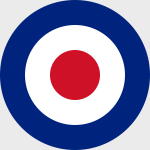Oxford OXFAC102 RAF De Havilland Mosquito Mk.II Night Fighter - 23 Squadron, 1943 (1:72 Scale)
"For some men of great courage and adventure, inactivity was a slow death. Would a man like Gibson ever have adjusted back to peacetime life? One can imagine it would have been a somewhat empty existence after all he had been through. Facing death had become his drug. He had seen countless friends and comrades perish in the great crusade. Perhaps something in him even welcomed the inevitability he had always felt that before the war ended he would join them in their Bomber Command Valhalla. He had pushed his luck beyond all limits and he knew it. But that was the kind of man he was - a man of great courage, inspiration and leadership. A man born for war - but born to fall in war."
- Barnes Wallis discussing the death of Guy Gibson, September 1944
 The "Mossie," as it was known affectionately by its British crews, was both simple in construction and design. It was a twin engine, single boom aircraft that placed the pilot and navigator in a side-by-side sitting configuration. The Mosquito was one of the most cost effective aircraft ever built because it was constructed out of wood. Balsa was used for the plywood skin, Sitka spruce from Alaska and British Columbia for the wing spars, and Douglas Fir stringers and birch and ash for the longitudinal pieces. These were all held together with glue and wood screws. The result was an airplane that was easy to maintain, tolerant of battle damage, and simple to patch. It was faster than the Spitfire, flew higher than almost any other aircraft, and carried tremendous firepower over great distances. The bomber version operated with relative impunity over Germany til the end of the war, because the Luftwaffe never had a nightfighter fast enough to intercept it. Interestingly, the nightfighter versions of the Mosquito remained in production until 1947, two years after the war in Europe had ended.
The "Mossie," as it was known affectionately by its British crews, was both simple in construction and design. It was a twin engine, single boom aircraft that placed the pilot and navigator in a side-by-side sitting configuration. The Mosquito was one of the most cost effective aircraft ever built because it was constructed out of wood. Balsa was used for the plywood skin, Sitka spruce from Alaska and British Columbia for the wing spars, and Douglas Fir stringers and birch and ash for the longitudinal pieces. These were all held together with glue and wood screws. The result was an airplane that was easy to maintain, tolerant of battle damage, and simple to patch. It was faster than the Spitfire, flew higher than almost any other aircraft, and carried tremendous firepower over great distances. The bomber version operated with relative impunity over Germany til the end of the war, because the Luftwaffe never had a nightfighter fast enough to intercept it. Interestingly, the nightfighter versions of the Mosquito remained in production until 1947, two years after the war in Europe had ended.
Pictured here is a 1:72 scale replica of a RAF De Havilland Mosquito Mosquito Mk.II night fighter that was attached to 23 Squadron during 1943.
Sold Out!
Dimensions:
Wingspan: 9-inches
Length: 6-3/4-inches
Release Date: February 2022
Historical Account: "Always on the Attack" - On the outbreak of the Second World War the squadron, still equipped with Blenheims, became a night-fighter squadron. The squadron scored its first victory of the war on June 18th, 1940, when a German Heinkel He 111 was shot down over Cley next the Sea, Norfolk, with another He 111 being shot down the same night, although two Blenheims were lost to return fire from German bombers. As the Blenheim was too slow and lightly armed to be an effective night fighter, the squadron began to operate in the night intruder role in December 1940, attacking German bombers as they returned to their airfields in France. From March 1941, the squadron replaced its Blenheims with the American Douglas Havoc, which were supplemented by the Boston III variant of the Havoc in February 1942.
In July 1942, the squadron re-equipped with the more capable de Havilland Mosquito. In December 1942 the squadron transferred to the Mediterranean, flying from RAF Luqa on Malta. It attacked enemy airfields and railway targets in Sicily, Tunisia and Italy through 1943, moving to Sardinia in December 1943, which allowed targets in Southern France to be attacked. In June 1944, the squadron returned to England, operating from RAF Little Snoring in Norfolk as part of 100 Group. The role of 100 Group was bomber support, i.e. to disrupt the Luftwaffe's attempts to stop the British bomber offensive, with 23 Squadron being tasked with low level night intruder operations against German night fighters. In addition to its normal night time operations, the squadron also carried out daylight bomber escort missions. 23 Squadron was disbanded, following the war's end, on September 25th, 1945.






![USAF Lockheed-Martin F-22 Air Dominance Fighter - "Pair-o-Dice", 90th Fighter Squadron "The Dicemen", 3rd Operations Group, 3rd Wing, Joint Base Elmendorf-Richardson, Alaska [Low-Vis Scheme] (1:72 Scale)](http://cdn4.volusion.store/qh9e9-jdqv9/v/vspfiles/photos/AF10117B-1.jpg?v-cache=1740197136)


